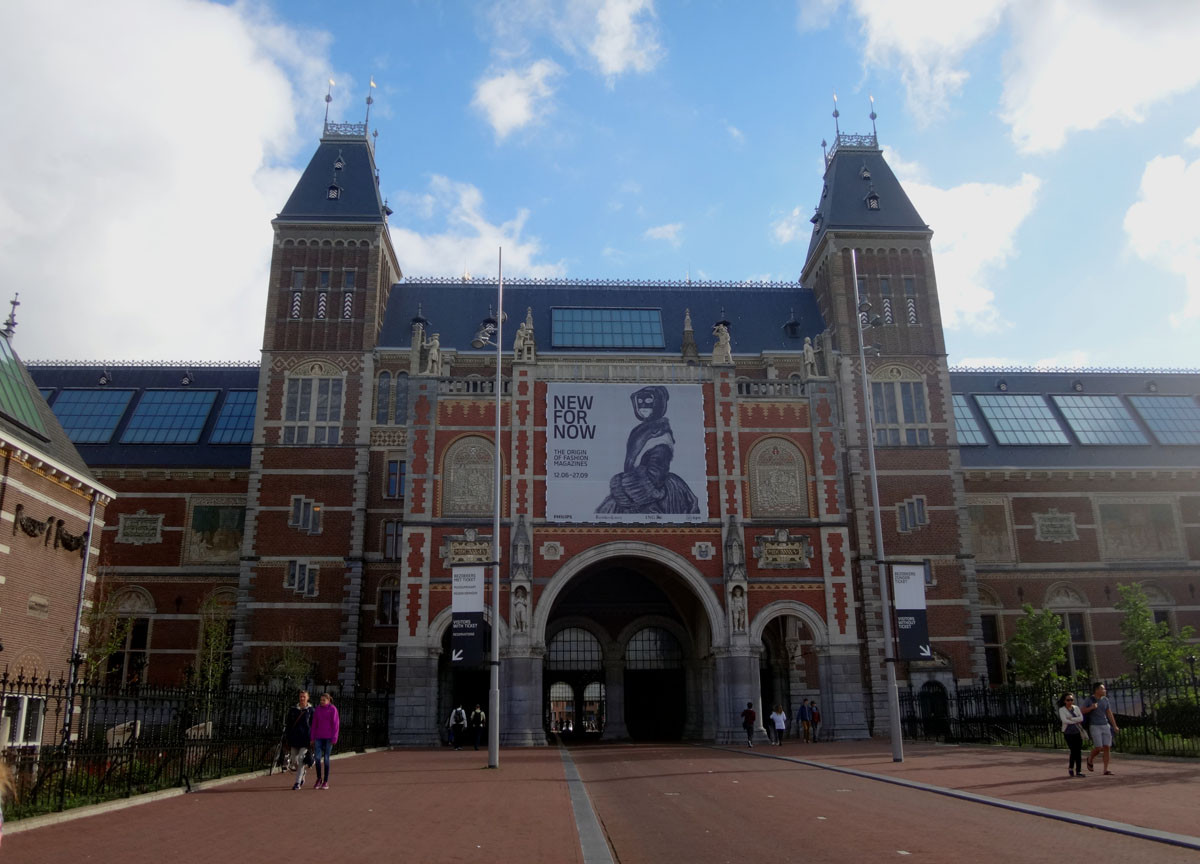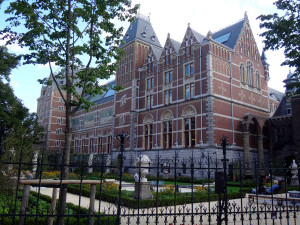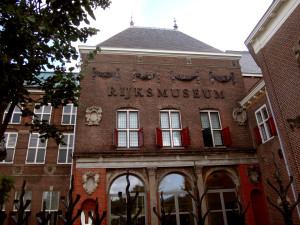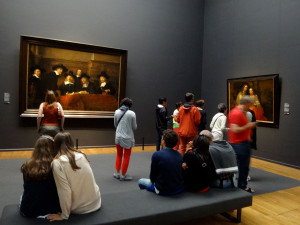Rijksmuseum
First off, the building itself is beautiful with a colorful brick exterior decorated with intricate designs of inlaid bricks. There is a feeling of graviats as you enter the building yet as you look up, the huge space fills with light and welcomes you to enter.
Secondly, the story of Dutch exploration and accumulated wealth is reflected in massive paintings of men at work and families at play, all richly dress and sporting elaborate jewelry. The Dutch lavishly support the arts so the museum has a bountiful display of great art as well as significant artifacts like furniture and boxes for storage of precious items. The entire museum is dedicated to arts, crafts and history.

You will see lots and lots of these kind of Dutch paintings across Europe. With no photography, back in the day, it was common for guilds and families to pose for portraits.
In this photo you can see how the painting looks on the wall at the Rijksmuseum. The painting on the left is the Drapers’ Guild; the painting on the right is The Jewish Bride.

This painting filled a long wall at the museum where it’s been a mighty crowd pleaser since 1885 and it was difficult to get close – so I borrowed this image from Wikipedia which says this is the best known painting in the Rijksmuseum’s collection. My source says, “The painting is renowned for three characteristics: its colossal size (363 cm × 437 cm (11.91 ft × 14.34 ft)), the effective use of light and shadow (chiaroscuro), and the perception of motion in what would have traditionally been a static military portrait.”
Each district of Amsterdam had a guard unit made up of about 120 men. This, most likely, was a guard unit who kept watch on their area of the city. “There were some 120 men in Frans Banning Cocq’s company, but only 19 of them are shown in the painting…Depending on where they were positioned, (the subjects) paid up to 100 guilders each to be included, and the captain and lieutenant no doubt paid more than that,” according to Rose-Marie and Rainer Hagen in “What Great Paintings Say – Volume 2.” This wasn’t a fighting unit – Amsterdam largely used mercenaries to fight their wars – it was really more of a guild of city leaders.
The next painting is one of my favorites. My little “bible” of art, Julian Porter’s “149 Paintings You Really Need to See in Europe” says, “When he saw this painting in 1885, Van Gogh said, ‘What an intimate, what an infinitely sympathetic painting. Believe me, and I mean this sincerely, I would have given 10 years of my life if I could sit for a fortnight before this painting with just a dry crust of bread to eat.‘” Yes, it’s that good.

In the book Rembrandt, Christopher White wrote, The Jewish Bride “is one of the greatest expressions of the tender fusion of spiritual and physical love in the history of painting.” No one is sure of who the people are in the portrait but some people think they were a couple posing as a biblical couple for this portrait.
The people of Amsterdam sometimes posed for portraits that depicted scenes from the Old Testament of the Bible. The Netherlands were a fairly new country when it became rich through trade in the 1650’s, so if painters wanted to paint history, some chose to paint bible history. This was a bit problematic because the country was heavily Calvinistic at this time and the religion placed restrictions on artistic subjects (paintings were even forbidden in Calvinist churches). Rose-Marie and Rainer Hagen discuss this in “What Great Paintings Say – Volume 3”, writing, “Calvin did not want paintings to be worshipped, his teachings thus forbad works of art depicting God, Jews, Mary or the martyrs of the Catholic Church.” That pretty much left the Old Testament. The Netherlands “certainly had no heroes who could hope to compare with the famous figures of the Old Testament.”

The Rijksmuseum has curated their collection in such a way that it is easy to understand not just the item but the context of the item. The picture above is a tiny self portrait by Rembrandt. The curation notes, in both Dutch and English, take up more wall space than the painting. This is terrific! I can easily see the text and the image, making my visit easy and interesting.
Here’s a typical sign that appeared next to the Drapers’ Guild painting. See how easy it is to understand both the history and the art?
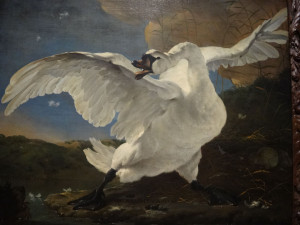
Isn’t this swan just magnificent? It fills a wall at the museum. This painting was so lifelike, I expected the swan to hiss at me.
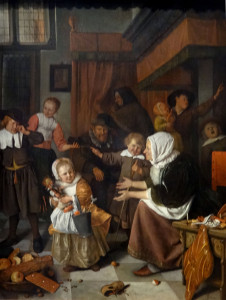
This isn’t one of the “greats” but I love it because it kind of reminds me of Christmas at our house when the kids were growing up. Note the child who got coal from St. Nicholas. Not good.

The Rijksmuseum is where I finally fell in love with Vermeer. I used to volunteer to teach art appreciation to students at my kids’ elementary school as part of a team of school docents. We introduced students to Vermeer but concentrated on his technique rather than content. Imagine my astonishment when I saw what the man could do beyond technique! The Milkmaid transforms the very space where it hangs with a rich butter-yellow tone that engulfs the room. Julian Porter writes, “The jumping blue of the balloon skirt against the flaxen yellow of the cloth blouse set under a gold pot against an ivory spotted wall flooded in light is a drawing room bravura act.” I already miss this painting.
Here is more great stuff at the Rijksmuseum showing the wealth made through trade.
There was an interesting exhibit of 21 Joan Miro sculptures in the Rijksmuseum Gardens, but we just ran out of time and didn’t visit. It was kind of funny that when we traveled to Barcelona to the Miro Museum, one of his sculptures was missing – it was back in Amsterdam and we had missed it there, too.

I did get to enjoy Miro’s Personnage 1975 as it was displayed in the Rijksmuseum lobby. I couldn’t find a sign telling me what I was seeing but people stopped and photographed the sculpture because it simply dominated the space.
So that’s the Rijksmuseum for this visit. I’ll be back again next summer 2016 and you can count on me adding to this page.

